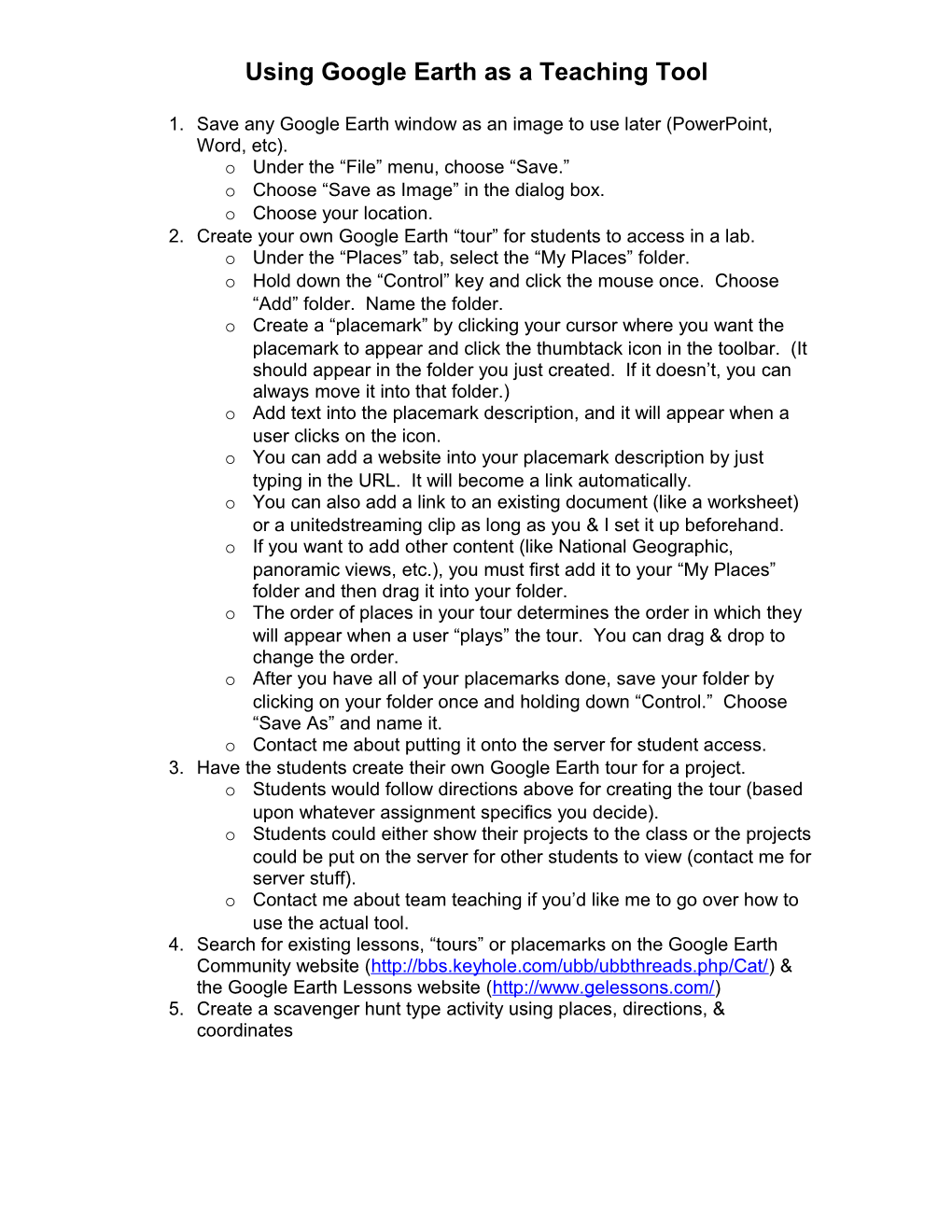Using Google Earth as a Teaching Tool
- Save any Google Earth window as an image to use later (PowerPoint, Word, etc).
- Under the “File” menu, choose “Save.”
- Choose “Save as Image” in the dialog box.
- Choose your location.
- Create your own Google Earth “tour” for students to access in a lab.
- Under the “Places” tab, select the “My Places” folder.
- Hold down the “Control” key and click the mouse once. Choose “Add” folder. Name the folder.
- Create a “placemark” by clicking your cursor where you want the placemark to appear and click the thumbtack icon in the toolbar. (It should appear in the folder you just created. If it doesn’t, you can always move it into that folder.)
- Add text into the placemark description, and it will appear when a user clicks on the icon.
- You can add a website into your placemark description by just typing in the URL. It will become a link automatically.
- You can also add a link to an existing document (like a worksheet) or a unitedstreaming clip as long as you & I set it up beforehand.
- If you want to add other content (like National Geographic, panoramic views, etc.), you must first add it to your “My Places” folder and then drag it into your folder.
- The order of places in your tour determines the order in which they will appear when a user “plays” the tour. You can drag & drop to change the order.
- After you have all of your placemarks done, save your folder by clicking on your folder once and holding down “Control.” Choose “Save As” and name it.
- Contact me about putting it onto the server for student access.
- Have the students create their own Google Earth tour for a project.
- Students would follow directions above for creating the tour (based upon whatever assignment specifics you decide).
- Students could either show their projects to the class or the projects could be put on the server for other students to view (contact me for server stuff).
- Contact me about team teaching if you’d like me to go over how to use the actual tool.
- Search for existing lessons, “tours” or placemarks on the Google Earth Community website ( & the Google Earth Lessons website (
- Create a scavenger hunt type activity using places, directions, & coordinates
Tips for using Google Earth:
Layers
- Turn off layers you don’t need as it can get very cluttered.
- Some layers are only visible from certain “heights.” If you don’t see anything for a layer you’ve enabled, try zooming in & out.
- Some layers are country specific – lots of U.S. information.
Places
- Don’t have too many placemarks or folders in your “Places” folder – save folders or placemarks you want to keep in a folder on your desktop or in your Documents folder. (Google Earth will load all information for your places, so if you have a lot saved, the application will take longer & longer to load.)
- Anything in your “Temporary Places” folder gets deleted upon quitting the application. Save anything you want to keep from that folder by moving it up into your “Places” folder.
- Make sure you hit “Play” & “Stop” when going through placemarks.
General
- Google Earth is right-click friendly (PC). On the Mac, you must have the control key pressed while clicking once with the mouse and this will bring up a list of commands.
- If you want to email one of your “tours” or folders, save it to your desktop first and then attach it in FirstClass (only Mail, Outlook Express, & Entourage are enabled for auto-email on the Mac).
- Uncheck anything you don’t what to see (both in the Layers section and in the Places section).
